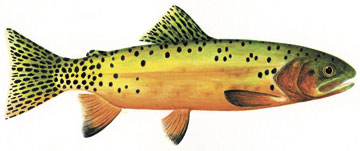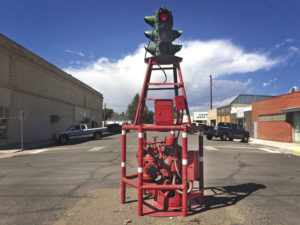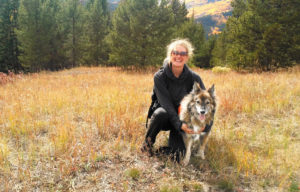By Tina Mitchell
In July, 2016, a lightning strike sparked the Hayden Pass Fire in the Sangre de Cristo Mountains. Within days, it had exploded into a 26-square-mile conflagration that forced area residents to evacuate. As they prepared to head out, firefighters raced in. Following close behind, a team of more than 30 specially trained wildlife staff and volunteers had one goal in mind – to save a fish from this fire. Not just any fish, but a genetically unique subspecies of greenback cutthroat trout found only in the South Prong of Hayden Creek, near Coaldale.
When they arrived at the lowest mile of the creek, the team found decent conditions. The fish were going about their ordinary pursuits. But for Greg Policky, the Colorado Parks and Wildlife (CPW) aquatic biologist heading the rescue effort, the biggest concern wasn’t necessarily the fire itself but the potential after-effects such as flash flooding and sediments or ash inundating the stream. By the end of the day, the wildlife team had removed 196 greenbacks from the South Prong. The Roaring Judy Fish Hatchery, between Gunnison and Crested Butte, took 158 of the fish. The remainder were released in Newlin Creek, a small stream in the Wet Mountains south of Cañon City. The team also left several hundred fish in the South Prong, hoping that any subsequent monsoon rains would spare the drainage so that these remaining fish could survive in their natural habitat.
Why put so much effort into the South Prong greenback cutthroat trout? Once widespread in the Arkansas and South Platte river drainages along the Front Range from Wyoming to New Mexico, the greenback subspecies of the cutthroat trout currently inhabits less than one percent of its historic range. Focusing on this one of the four subspecies of cutthroat trout found in Colorado, extensive genetic work in 2012 revealed that this native cutthroat subspecies now existed only in a four-mile stretch of a single stream – Bear Creek, along the eastern flank of Pikes Peak. This same genetic work revealed another surprise. The greenbacks in the South Prong of Hayden Creek – and now in the Roaring Judy hatchery and Newlin Creek – contain genes found in no other living fish. In fact, their genes match only two museum specimens in the Smithsonian Institution, collected in 1889 by ichthyologist David Starr Jordan from Twin Lakes, near Leadville. (See this column in the November, 2016, archive of Colorado Central at www.coloradocentralmagazine.com for more background on this subspecies.)
[InContentAdTwo]
Policky wasn’t the only one worried about post-fire monsoon flooding. Area residents also lived on tenterhooks, haunted by the same concerns. And indeed on August 23 – just a few weeks before CPW’s planned return to check on the remaining South Prong greenbacks – a massive thunderstorm erupted over the slopes above Hayden Creek, signaling serious trouble again for both human and fish inhabitants. A major flash flood swept down the creek, rerouting the stream bed in numerous places; digging fast-flowing channels; and scraping former gravel-strewn spawning habitat down to bedrock. Returning to the South Prong after the flood, the wildlife team faced a bleak reality: not a single greenback found after a full day of painstakingly searching the lower two miles. The flood may have washed the remaining fish downstream into Hayden Creek below the confluence of the North, Middle and South Prongs, where they would interbreed with other species and be genetically lost. Or perhaps the rushing waters simply buried the fish in the sediment. Either way, they were gone.
That day’s results certainly painted a grim picture for the South Prong greenbacks. The wildlife team does plan to return again this fall, just in case a few hardy survivors might still exist. But because Policky had hoped for the best but planned for the worst, CPW’s work early during the fire had saved this unique subspecies of greenback cutthroat trout from extinction. Despite the depressing fate of the population left behind in the South Prong, Colorado still has two back-up populations of this precious subspecies. One survives, wild and free, in Newlin Creek. The other is now being successfully propagated at the Roaring Judy as a source population to restock Colorado streams. Perhaps, after stream improvements and habitat rehabilitation, even the South Prong of Hayden Creek once again. Someday.




